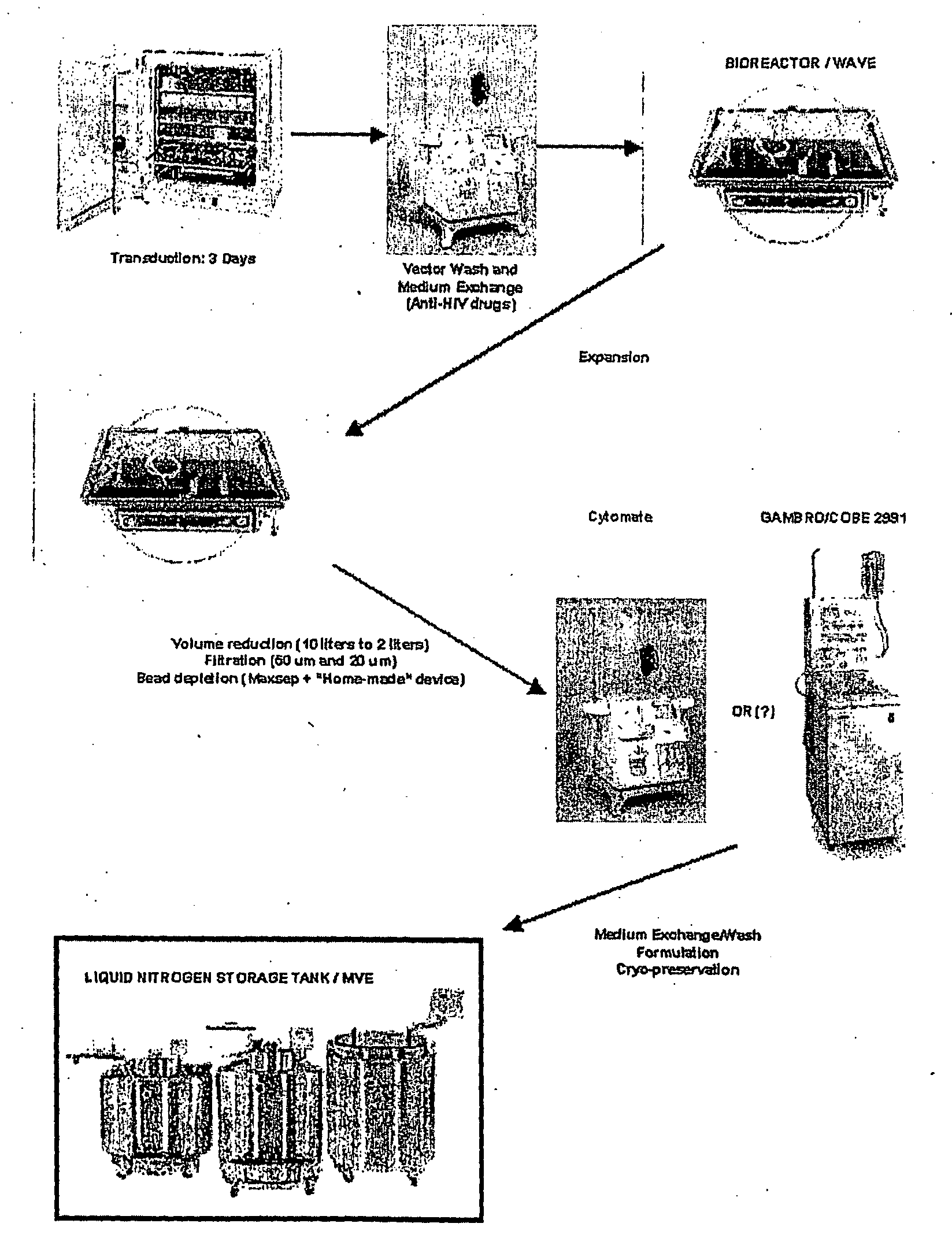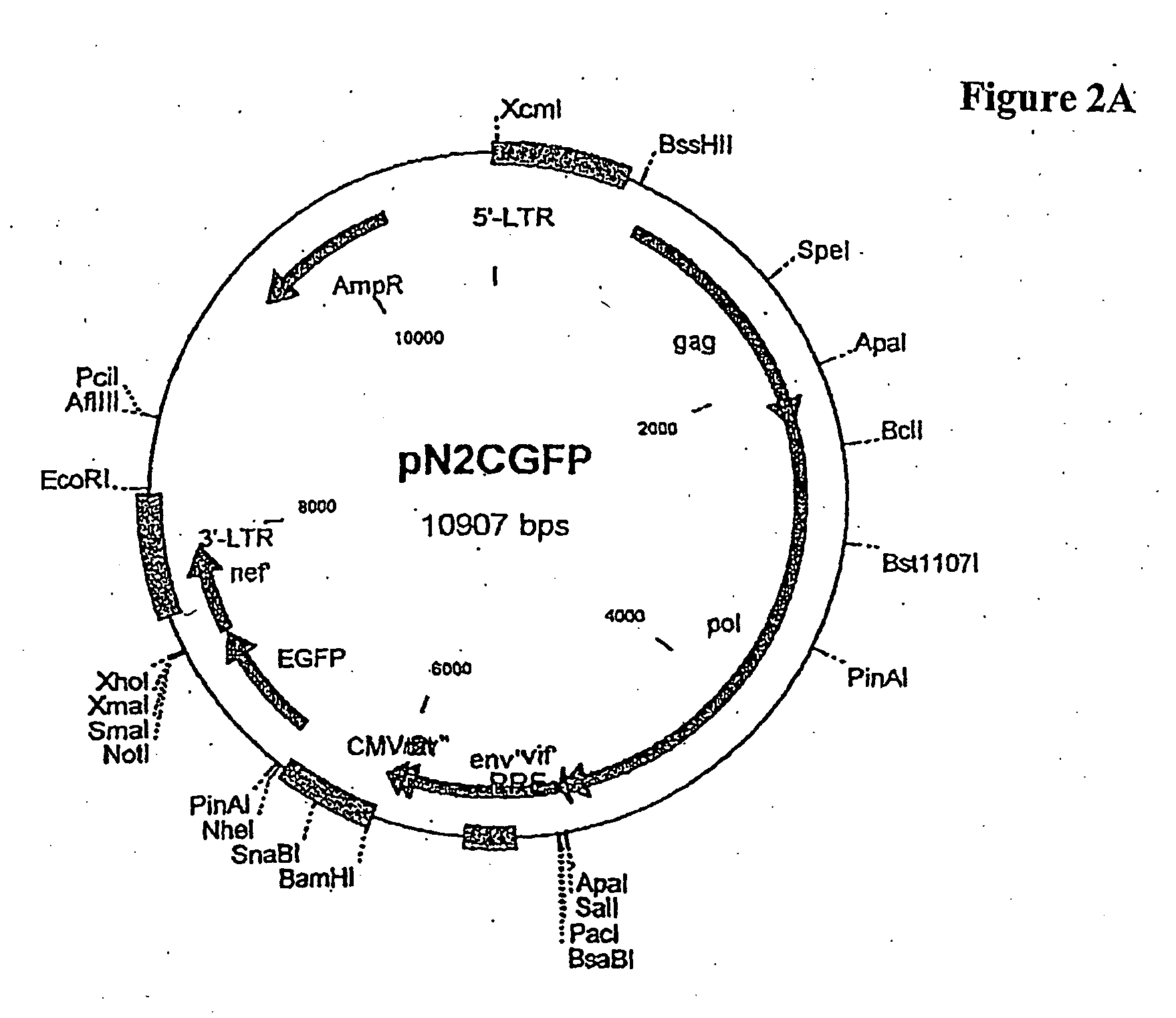Autologous T Cell Manufacturing Processes
- Summary
- Abstract
- Description
- Claims
- Application Information
AI Technical Summary
Benefits of technology
Problems solved by technology
Method used
Image
Examples
example 2
Transduction of Primary CD4+ T Cells with Variations in Time of Contact with a Cell Surface Binding Molecule
[0209]Transduction Before Cell Surface Binding
[0210]Primary CD4+ cells (about 500,000) were cultured with pN2cGFP at a MOI of 20 for 24 hours followed by addition of αCD3 and αCD28 coated beads to the culture for an additional seven days. FIG. 2 contains a map of pN2cGFP.
[0211]Transduction after Cell Surface Binding
[0212]Primary CD4+ cells (about 500,000) were cultured for 24 hours with αCD3 and αCD28 coated beads for 24 hours followed by introduction of pN2cGFP at a MOI of 20 to the culture for an additional 24 hours. The cells were washed to remove excess vector followed by incubation in vector free media containing the beads for an additional seven days.
[0213]Simultaneous Transduction and Cell Surface Binding
[0214]Primary CD4+ cells (about 500,000) were cultured with pN2cGFP at a MOI of 20 for 24 hours in the presence of αCD3 and αCD28 coated beads. The cells were washed to...
example 3
Post-Transduction Analysis
[0218]Post-transduction and seven or 14 days after incubation, the cells were analyzed by flow cytometry for CD4+ and / or green fluorescent protein (GFP).
[0219]A comparison of the above three transduction protocols is shown in FIG. 3. Contact with bead immobilized CD3 and CD28 antibodies after transduction with pN2cGFP at an MOI of 20 resulted in about 91% efficiency. Contact with beads before transduction resulted in about 89% efficiency, and simultaneous bead contact and transduction resulted in about 80% efficiency. In this experiment, the CD4+ T cells were selected by adherence monocyte depletion, CD14 MACS depletion and CD4 MACS enrichment. The antibodies were immobilized as described below. Contact with the vector was at 37° C. and 5% CO2. The culture conditions were at 500,000 CD4+ T cells per ml in Yssel's medium supplemented with 2% human serum albumin. FACS analysis was on day seven post selection. MF refers to mean fluorescence.
[0220]The results f...
example 4
Different Vectors Stably Transduce Cells at High Efficiencies
[0222]This example is a comparison of vectors used for transduction. pN2cGFP contains the entire gag and pol coding sequence while pN1(cpt)cGFP contains the 4551-5096 partial (non-coding) pol sequence. As can be seen from the results, shown in FIG. 6, both vectors show very efficient transduction of primary CD4 cells after simultaneous stimulation with bead immobilized CD3 and CD28 antibodies and vector at an MOI of 20. FACS analysis was performed on day 10 post selection.
PUM
| Property | Measurement | Unit |
|---|---|---|
| Fraction | aaaaa | aaaaa |
| Fraction | aaaaa | aaaaa |
| Fraction | aaaaa | aaaaa |
Abstract
Description
Claims
Application Information
 Login to View More
Login to View More - R&D
- Intellectual Property
- Life Sciences
- Materials
- Tech Scout
- Unparalleled Data Quality
- Higher Quality Content
- 60% Fewer Hallucinations
Browse by: Latest US Patents, China's latest patents, Technical Efficacy Thesaurus, Application Domain, Technology Topic, Popular Technical Reports.
© 2025 PatSnap. All rights reserved.Legal|Privacy policy|Modern Slavery Act Transparency Statement|Sitemap|About US| Contact US: help@patsnap.com



